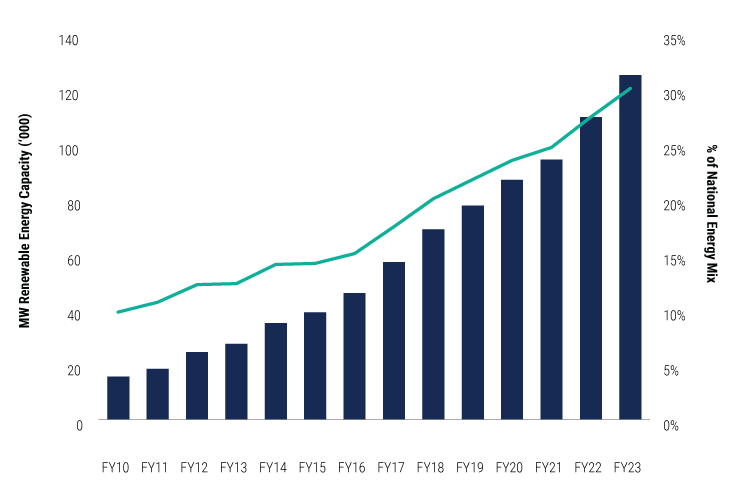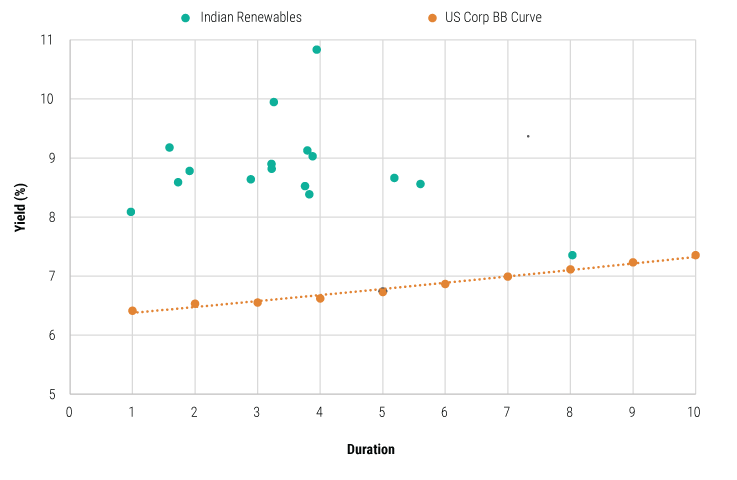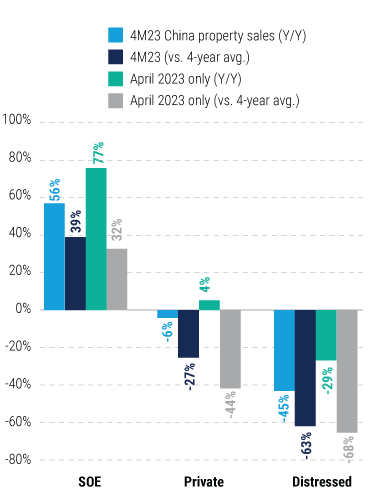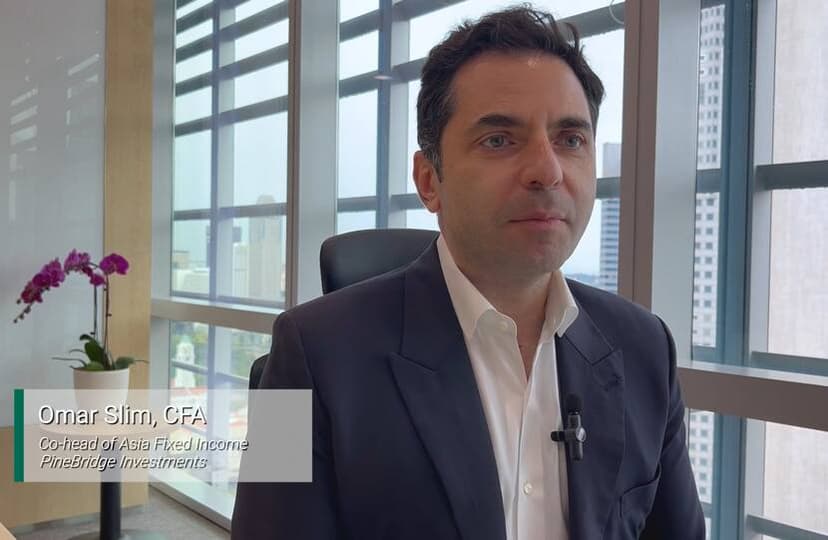Asia’s High Yield Market: Attractive Alpha Opportunities for Disciplined Credit Selectors

Andy Suen, CFA, FRM
Co-Head of Asia Fixed Income

Omar Slim, CFA
Co-Head of Asia Fixed Income

Kelvin Heng
Portfolio Manager and Credit Analyst, Fixed Income

Karen Kwan
Senior Credit Analyst, Fixed Income

Sharon Chang, CFA
Credit Analyst, Fixed Income

With Chinese property now a less prominent sector within Asia’s high yield landscape, the relatively low default rates of the rest of the region’s corporates enable disciplined credit selectors to find attractive opportunities amid today’s market disruption.
We see four key themes for generating alpha selectively in Asia’s high yield market: beneficiaries of the consumption-led recovery in China and across Asia; beneficiaries of the decarbonization trend; the small number of robust Chinese property developers with large investment property portfolios and better-quality land banks in top-tier cities; and credits with a strong liquidity backdrop.
Active managers with robust investment processes can show their differentiation by using current market dislocation to source alpha in Asia’s credit market.
Asia’s high yield (HY) market has felt the prolonged downturn in China’s property sector deeply. While sentiment has not yet fully recovered, we think the current market dislocation offers disciplined credit selectors scope to uncover attractive risk/reward opportunities.
We expect distressed Chinese property credits to continue to make headlines, with a knock-on effect on index volatility and returns. However, the reality today is that these names make up only 10% of the JACI HY index, down from around 35% two years ago.1
Further, when excluding this sector, the default rate of Asian HY corporates is projected to remain low on the back of a relatively more favorable macro backdrop in the region.
As a result, putting aside Chinese property, we expect stable-to-improving credit fundamentals within Asian HY as growth in the region accelerates, in stark contrast to the situation in developed economies, thanks to China’s recovery and broadly supportive policy environment amid its post-pandemic growth.
With this in mind, we identify four of the major alpha generation themes for the asset class:
Beneficiaries of Asia’s consumption-led recovery
Beneficiaries of the decarbonization trend
The most robust Chinese property developers
Credits with a strong liquidity backdrop
Asia Growth to Accelerate in 2023

Source: PineBridge Investments as of 30 May 2023, *IMF World Economic Outlook, updated as of April 2023. For illustrative purposes only. We are not soliciting or recommending any action based on this material. Any views represent the opinion of the Investment Manager, are valid as of the date indicated, and are subject to change.
Asia ex-China Property Corporate Default Rate Expected to Remain

Sources: JP Morgan, PineBridge Investments, as of 30 April 2023. Any opinions, projections, forecasts, or forward-looking statements presented are valid only as of the date indicated and are subject to change. We are not soliciting or recommending any action based on this material. Past performance, or any prediction, projection or forecast, is not indicative of future performance.
Asia High Yield Offers Higher Carry and Shorter Duration

Sources: Data as of 26 May 2023, BofA ICE index, PineBridge Investments. Asia HY and countries are represented by the breakdown of ICE BofA Asian Dollar High Yield Corporate Index, and US HY by ICE BofA US High Yield Index.
Theme 1 – Beneficiaries of Asia’s consumption-led recovery
We were expecting China’s economic recovery to be bumpy and uneven, and the data points so far this year reflect this. As a result, market participants have been readjusting – downward – their initial optimistic growth forecasts, resulting in the correction of China-related assets, including HY credits.
While we think China is unlikely this year to live up to some of the more bullish projections, we continue to expect growth to accelerate from 2022 and to meet the government’s target of 5% for 2023. This is a supportive macro backdrop for credits.
We also believe the swing in sentiment in recent weeks presents opportunities for investors to position themselves again to capitalize on the reopening recovery theme – not just in China, but across the region. We expect this to be more consumption and service sector driven.
The Macau gaming sector is a case in point. The city’s recovery is trending strongly, with the May 2023 gross gaming revenue (GGR) reaching 60% of its 2019 level, implying positive free cash flow generation. We expect the sector will continue to see positive credit rating revisions.
More broadly, the following relative value chart highlights select credits in consumer-related sectors in the Asia region, showing what we think is an attractive pickup over HY credits elsewhere.
[DOUBLE COLUMN CHART GOES HERE]
China Retail Sales Expected to Deliver Double-Digit Growth

Macau Gross Gaming Revenue Recovery Continues to Beat Expectations

Source: MacroBond, Bloomberg, DICJ, Company data, PineBridge Investments as of 31 March 2023. For illustrative purposes only. We are not soliciting or recommending any action based on this material. Any views represent the opinion of the Investment Manager, are valid as of the date indicated, and are subject to change.
Theme 2 – Beneficiaries of the decarbonization trend
The Indian renewables sector has in recent years grown into the largest segment of the Indian HY universe. Ambitious national environmental targets include a goal to grow overall capacity from around 170 GW currently to 500 GW by 2030, largely led by solar power (450 GW) followed by wind power. Combined with the associated sizable financing needs, we expect this to remain a mainstay of the Asian USD HY market for years to come.
While the sector is not without its challenges, its favorable ESG positioning is providing a number of fundamental tailwinds. Most notably, government policy and regulatory support are increasingly forthcoming amid the need to achieve India’s envisaged growth. There is also an increasingly strong push to fix some of the more structural and longstanding issues in this space – one of the biggest being delayed payments to generation companies from state distribution offtakers.
The Late Payment Surcharge (LPS) scheme is one of the more recent policies, introduced last year, that has incentivized state distribution companies to clear these overdue balances. In turn, this has bolstered cash flows for a number of the major renewable players.
At the same time, funding access across debt and equity channels has remained strong relative to other Asian HY segments, with solid appetite from onshore lenders and continued strong sponsor commitments.
Despite the favorable tailwinds discussed above, overall valuations in the sector have improved since the start of 2022. It now offers an attractive pickup over similarly rated developed market HY bonds.
Renewables Sector to Benefit From Policy Tailwinds

Sources: JP Morgan, PineBridge Investments, Central Electricity Authority India, as of 1 May 2023. For illustrative purpose only. Any opinions, projections, forecasts, or forward-looking statements presented are valid only as of the date indicated and are subject to change. We are not soliciting or recommending any action based on this material. Past performance, or any prediction, projection or forecast, is not indicative of future performance.
Indian Renewable HY Bonds Offer Yield Pickup Over DM HY

Source: PineBridge Investments, Bloomberg as of 2 June 2023.
Theme 3 – The most robust Chinese property developers
Following major policy shifts in China in late 2022 , the property market has shown some signs of recovery in early 2023. However, sales momentum faded once again in the second quarter, particularly in the lower-tier cities.
As discussed previously, we expect an L-shaped trajectory for property sales, as we interpret the policy objective as intended to stabilize the market rather than engineer a sharp recovery.
We are not constructive on the distressed space and expect a prolonged restructuring process for most default cases. That said, we expect a (very) small number of higher-quality companies to survive this downturn. Those companies with larger investment property portfolios and better-quality land banks in top-tier cities will be more resilient.
Active investors will need to continually reassess borderline cases, as their outlook depends on the execution of any supportive policies and different companies’ own sales progress.
China’s Property Sector Recovery Is Highly Uneven, Making Selectivity Critical


Sources: Left - CRIC, CREIS, EH Consulting, company data, J.P. Morgan, PineBridge Investments, as of April 2023. Right - CRIC, CREIS, Citi, PineBridge Investments, as of March 2023.
China Property High Yield Has Shrunk to 10% of JACI HY Index

Source: PineBridge estimates, JP Morgan, as of 30 May 2023. Based on JACI Index members; defaulted bonds not eligible for index inclusion. Any opinions, projections, forecasts, or forward looking statements presented are valid only as of the date indicated and are subject to change. For illustrative purposes only.
Theme 4 – Credits with a strong liquidity backdrop
There have been multiple cases of tenders, buybacks, or early calls by issuers with strong liquidity positions. Cheaper alternative funding or strong operating cash flow generation have supported this activity, and we expect this theme to remain a source of alpha opportunities.
The magnitude of monetary tightening in Asia has been smaller than that in the developed markets, and China has been easing policies. As a result, Asian corporates are facing less pressure from increasing funding costs compared with corporates in other regions. Stronger credits in major economies can tap domestic funding channels in the form of loans or bonds. And in terms of cash flow generation, commodities companies have built up large cash buffers from periods of elevated commodity prices. The table below lists a number of such examples.
Much Less Hawkish Monetary Policies Among Asian Central Banks

Source: Bloomberg, PineBridge Investments, as of 24 May 2023. For illustrative purposes only. We are not soliciting or recommending any action based on this material. Forecasts are by PineBridge Investments and methodology is based on an overall assessment of the economy in individual countries as well as the external rates environment. Any opinions, projections, forecasts, and forward- looking statements presented are valid only as of the date indicated and are subject to change.
Credits With Strong Liquidity Backdrop Are Redeeming USD Bonds

Source: MacroBond, Bloomberg, DICJ, Company data, PineBridge Investments as of 31 March 2023. For illustrative purposes only. We are not soliciting or recommending any action based on this material. Any views represent the opinion of the Investment Manager, are valid as of the date indicated, and are subject to change.
Readying for a selective return to Asian HY
The significant return dispersion and credit events in the Asian HY credit market over the past two years have served as a stress test for asset managers’ credit investment processes.
Significant dislocation in the market persists, and we believe this environment is conducive to active managers with robust investment processes in place to generate alpha.
As an active manager with a wealth of experience in Asian credit investing, PineBridge continues to take a disciplined approach to uncovering opportunities in these and other markets and sectors where we see compelling alpha potential.
Footnote
1 Source: PineBridge estimates, JP Morgan, as of 30 May 2023. Based on JACI Index members; defaulted bonds not eligible for index inclusion. Any opinions, projections, forecasts, or forward looking statements presented are valid only as of the date indicated and are subject to change. For illustrative purposes only.
Disclosure
Investing involves risk, including possible loss of principal. The information presented herein is for illustrative purposes only and should not be considered reflective of any particular security, strategy, or investment product. It represents a general assessment of the markets at a specific time and is not a guarantee of future performance results or market movement. This material does not constitute investment, financial, legal, tax, or other advice; investment research or a product of any research department; an offer to sell, or the solicitation of an offer to purchase any security or interest in a fund; or a recommendation for any investment product or strategy. PineBridge Investments is not soliciting or recommending any action based on information in this document. Any opinions, projections, or forward-looking statements expressed herein are solely those of the author, may differ from the views or opinions expressed by other areas of PineBridge Investments, and are only for general informational purposes as of the date indicated. Views may be based on third-party data that has not been independently verified. PineBridge Investments does not approve of or endorse any republication of this material. You are solely responsible for deciding whether any investment product or strategy is appropriate for you based upon your investment goals, financial situation and tolerance for risk.




